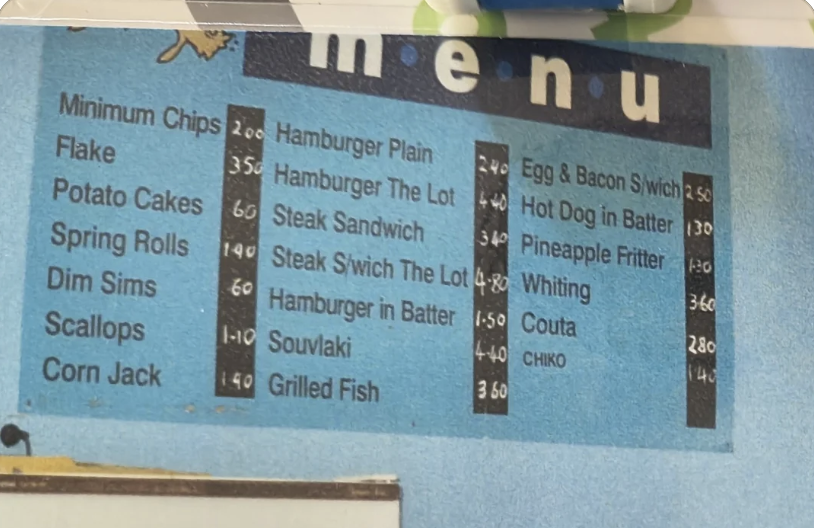
Remember when a night out at the local fish and chip shop meant scrounging around for loose change in the car console?
A nostalgic discovery on social media has Australians doing a double-take at just how dramatically our beloved takeaway tradition has transformed over the past two decades.
A Melbourne resident recently shared a photograph of their parents' old fish and chip shop menu from 2003, and the prices have left many feeling both wistful and wallet-shocked. The Yarraville establishment was charging $4.40 for a hamburger with the lot, $2 for chips, and just 60 cents for potato cakes.
The numbers that tell the story
Today, feeding a family of four from the local takeaway can easily cost over $100. Just two decades ago, back in 2003, that same meal might have set you back less than $20.
The menu, which quickly went viral on social media, sparked a wave of nostalgia and financial reality checks. 'The $2 minimum chips that could feed your family,' one commenter reminisced, while another calculated that '$18 would easily feed a family of four on that menu.'
But it's the modern comparison that really stings. 'Cries in $20 burgers and $5 chip minimum,' one person responded, while another shared their recent experience: 'Fish and chips for two adults cost me $45 in Perth tonight.'
'Our fish and chips last night cost $61.80, would have been $19.80 back then. The average salary didn't rise 300 per cent obviously'
More than just inflation at work
According to official Australian inflation data, $100 in 2000 is equivalent to $194.55 in 2025, which suggests standard inflation would have roughly doubled prices over this period. But the fish and chips experience shows increases far beyond general inflation rates.
Since 2019 alone, the cost of eating out in Australia has increased by a staggering 34 per cent. This acceleration has coincided with rising costs across the supply chain—from fishing and farming to energy, rent, and wages in the hospitality sector.
Understanding the real impact on your budget
While general inflation has roughly doubled prices since 2003, food inflation has been more dramatic:
- Food and beverage inflation: 3 per cent annually as of June 2025
- Overall inflation: 2.1 per cent annually as of June 2025
- Wage growth: 3.4 per cent annually as of June 2025
Source: Australian Bureau of Statistics, June 2025
The generational divide
For Australians over 60, this price comparison hits particularly close to home. Many remember when fish and chips was the affordable family treat—the go-to option when the budget was tight or when you wanted to spoil the kids without breaking the bank.
'I remember minimum chips being 20 cents,' shared one nostalgic commenter, while another recalled when '$5 chips could feed a family of 4.'
The challenge is that while Australian inflation may have moderated to 2.1 per cent annually in mid-2025, wages haven't kept pace for everyone. Despite average wage growth of 4.3 per cent in 2024, real wages for many industries are still below pre-pandemic levels.
For those on fixed incomes—including many retirees—these price increases represent a genuine squeeze on discretionary spending. What was once an affordable weekly treat has become an occasional luxury.
The premium fish and chips phenomenon
The transformation isn't just about standard fish and chips either. Earlier this month, a Perth venue made headlines for charging $96.39 for two pieces of snapper with small chips, a crab stick, pineapple, calamari, and two tartare sauces at Amberjacks Cottesloe.
In Melbourne, Republica in St Kilda charges $34 for fish and chips, dividing opinions about whether gourmet fish and chips justify such premium pricing.
These examples represent a broader shift in the industry, where many establishments have moved upmarket, offering premium fish varieties, gourmet batters, and restaurant-style presentations—along with restaurant-style prices.
Smart strategies for fish and chip lovers
Despite the price increases, you don't have to give up this Australian tradition entirely. Here are some budget-friendly approaches:
Look for traditional shops: Family-run establishments often maintain more reasonable pricing compared to trendy coastal venues.
Share and supplement: Order family packs and add your own salad or bread at home to stretch the meal further.
Check for pensioner discounts: Many local fish and chip shops offer senior discounts, especially on quieter weekday afternoons.
Consider lunch specials: Many shops offer better value during lunch hours when they're trying to attract customers.
Stick to basics: Fancy fish varieties and gourmet additions add significant cost—sometimes traditional flake and standard chips deliver the same satisfaction.
Making fish and chips work for your budget
- Traditional family shops often have better prices than trendy venues
- Lunch specials and senior discounts can provide significant savings
- Sharing family packs and supplementing at home stretches your dollar
- Basic menu items often deliver the same satisfaction as premium options
The bigger picture
The eye-watering difference is more than just inflation; it's a tangible symbol of the financial pressures currently gripping Australian households. While Australians don't need a reminder of the rising cost of groceries, rent, and fuel, the data confirms the pain at the counter.
For many, that 2003 menu represents more than just cheap food—it symbolises a time when modest incomes went further, when families could afford small luxuries more easily, and when a trip to the local fish and chip shop was about the food, not the financial calculation.
The viral menu has clearly struck a chord because it makes abstract economic concepts tangible. It's one thing to hear about inflation rates and cost of living pressures—it's another to see the actual menu prices that once seemed normal.
Looking forward
While the price increases are undeniable, there's still value to be found for those willing to seek it out. The key is adjusting expectations and strategies rather than abandoning the tradition altogether.
The good news is that average real wage growth is finally positive at around 2.0 per cent, but this varies dramatically by industry and individual circumstances. For many Australians, particularly those on fixed incomes, the challenge remains finding ways to maintain cherished traditions within tighter budgets.
That 2003 menu serves as more than just a nostalgic curiosity—it's a reminder of how much Australian life has changed, and perhaps a prompt to appreciate both the fish and chips we can afford and the memories of when they cost pocket change.
What are your memories of fish and chip prices from years gone by? Do you have strategies for getting good value at your local shop? Share your experiences and tips with fellow members in the comments below—we'd love to hear how you're navigating these price changes while keeping this beloved Australian tradition alive.
Read more: The prices of this popular food choice soar across Australia: what seniors need to know
Primary Source
https://www.kidspot.com.au/lifestyl...s/news-story/bb053b70151c07448ecff6a61c11009f
Inflation Rate between 2000-2025 | Australia Inflation Calculator
Cited text: $100 in 2000 is now equivalent to $194.55 in 2025.
Excerpt: $100 in 2000 is equivalent to $194.55 in 2025
https://www.in2013dollars.com/australia/inflation/2000?amount=100&endYear=2025
Cost of Living on Full Display with Viral Fish 'N Chip Menu from 2003—5RM
Cited text: Since 2019, the cost of eating out in Australia has increased by a staggering 34 per cent.
Excerpt: Since 2019, eating out has increased by 34 per cent
https://www.5rm.com.au/trending/sto...isplay-with-viral-fish-n-chip-menu-from-2003/
Salary vs Inflation: Is Your Pay Keeping Up in 2025? (Australia)
Cited text: Australian inflation may have moderated to 2.1 per cent annually in mid-2025, but wages haven't kept pace for everyone. Despite average wage growth of 4.3 per cent in...
Excerpt: Wages haven't kept pace despite 4.3 per cent growth in 2024, real wages still below pre-pandemic levels
https://www.ultimatesalarycalculator.com/au/blog/salary-vs-inflation-calculator-australia-2025
Australia’s Inflation Rate: Latest Data, History, Background
Cited text: As of June 2025, annual 'food and non-alcoholic beverage' price inflation was 3 per cent.
Excerpt: Food inflation at 3 per cent as of June 2025
https://www.savings.com.au/statistics/what-is-the-inflation-rate-australia
Australia’s Inflation Rate: Latest Data, History, Background
Cited text: As of June 2025, annual 'food and non-alcoholic beverage' price inflation was 3 per cent.
Excerpt: Food inflation at 3 per cent as of June 2025
https://www.savings.com.au/statistics/what-is-the-inflation-rate-australia
Cost of Living on Full Display with Viral Fish 'N Chip Menu from 2003—LAFM
Cited text: Today, feeding a family of four from the local takeaway can easily cost over $100. Just two decades ago, back in 2003, that same meal might have set y...
Excerpt: Today, feeding a family of four from the local takeaway can easily cost over $100.
https://www.lafm.com.au/trending/st...isplay-with-viral-fish-n-chip-menu-from-2003/
Cost of Living on Full Display with Viral Fish 'N Chip Menu from 2003—LAFM
Cited text: The eye-watering difference is more than just inflation; it’s a tangible symbol of the financial pressures currently gripping Australian households. W...
Excerpt: The eye-watering difference is more than just inflation; it's a tangible symbol of the financial pressures currently gripping Australian households.
https://www.lafm.com.au/trending/st...isplay-with-viral-fish-n-chip-menu-from-2003/
Salary vs Inflation: Is Your Pay Keeping Up in 2025? (Australia)
Cited text: The good news is that average real wage growth is finally positive at around 2.0 per cent, but this varies dramatically by industry and individual circumstanc...
Excerpt: The good news is that average real wage growth is finally positive at around 2.0 per cent, but this varies dramatically by industry and individual circumstances.
https://www.ultimatesalarycalculator.com/au/blog/salary-vs-inflation-calculator-australia-2025







